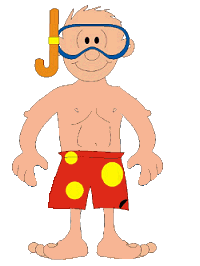




![]()
![]()

![]()
![]()
![]()
![]()
![]()
![]()
 |
I love to eat crustaceans. How about you?
|
 |
Background: Look at preserved specimens of hermit crabs, fiddler crabs, ghost crabs, stone crabs, shrimp, and lobsters during this part of the unit to discover the characteristics of crustaceans. Crustaceans are invertebrates characterized by an external skeleton and jointed appendages. They breathe through gills, and molt or shed their exoskeletons as they grow. Point out that horseshoe crabs are not crustaceans and are in the same class as spiders and scorpions. The odd ball of this group is the barnacle, think of him as a crab stuck to a rock by his head and waving his feet in the air to catch food.
|
Back to Under the Sea ~ Fishy Links - Ocean Life Links ~ Teacher's Guide
Fishy Tales - Student Storybooks for Under the Sea ~ Fishy Fun
© 2001 S. Seagraves
Be sure to visit our classroom web site for more thematic units, lesson plans and online activities